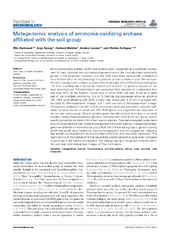Metagenomic analysis of ammonia-oxidizing archaea affiliated with the soil group
Peer reviewed, Journal article
Published version
Permanent lenke
http://hdl.handle.net/1956/7469Utgivelsesdato
2012-06-20Metadata
Vis full innførselSamlinger
Originalversjon
https://doi.org/10.3389/fmicb.2012.00208Sammendrag
Ammonia-oxidizing archaea (AOA) have recently been recognized as a significant compo- nent of many microbial communities and represent one of the most abundant prokaryotic groups in the biosphere. H owever, only few AOA have been successfully cultivated so far and information on the physiology and genomic content remains scarce. We have per- formed a metagenomic analysis to extend the knowledge of the AOA affiliated with group I.1b that is widespread in terrestrial habitats and of which no genome sequences has been described yet. A fosmid library was generated from samples of a radioactive ther- mal cave (46 ̊C) in the Austrian Central Alps in which AOA had been found as a major part of the microbial community. Out of 16 fosmids that possessed either an amo Aor 16S rRNA gene affiliating with AOA, 5 were fully sequenced, 4 of which grouped with the soil/I.1b ( Nitrososphaera -) lineage, and 1 with marine/I.1a ( Nitrosopumilus -) lineage. Phylogenetic analyses of amo BC and an associated conserved gene were congruent with earlier analyses based on amo A and 16S rRNA genes and supported the separation of the soil and marine group. Several putative genes that did not have homologs in currently available marine Thaumarchaeota genomes indicated that AOA of the soil group contain specific genes that are distinct from their marine relatives. Potential cis -regulatory elements around conserved promoter motifs found upstream of the amo genes in sequenced (meta-) genomes differed in marine and soil group AOA. On one fosmid, a group of genes including amo A and amo B were flanked by identical transposable insertion sequences, indicating that amo AB could potentially be co-mobilized in the form of a composite transposon. This might be one of the mechanisms that caused the greater variation in gene order compared to genomes in the marine counterparts. Our findings highlight the genetic diversity within the two major and widespread lineages of Thaumarchaeota.

